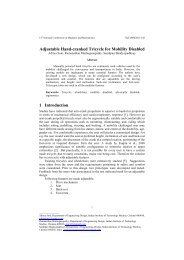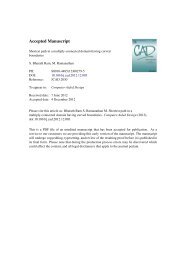Lecture 16
Lecture 16
Lecture 16
You also want an ePaper? Increase the reach of your titles
YUMPU automatically turns print PDFs into web optimized ePapers that Google loves.
Rubber Polymer type : Chloroprene Rubber2.3.3 Polychloroprene CRThe CR ( chloroprene rubber), more popularly known as Neoprene.• it has a measure of both oil and weather resistance.• The oil resistance would only be considered moderate.• CR has similar dynamic mechanical characteristics to NR, including goodmechanical strength .• CR has some ability to retard flame, which means that when a source of flameis removed, the burning polymer will have a tendency to self extinguish, (thiscan be modified to improve or unintentionally diminish this property), whileNR, EPDM, and SBR for example, will continue to burn.• Upper continuous heat aging resistance temperature limits are of the order of90 ˚C. SAE defines continuous upper temperature resistance as, thetemperature at which the material retains a minimum of 50% of both originalelongation and tensile strength at break after 1008 hours (6 weeks).• Recommended upper range for CR in air is 99 ˚C for 1,000 cumulative hours and85 ˚C for 10,000 cumulative hours. Other sources put it at 91 ˚C for 1,000cumulative hours and 85 ˚C for 10,000 cumulative hours.• CR shows some stiffening at around -18 ˚C , becoming brittle around -40 deg C,although this can be lowered using certain compounding ingredients.• Resistance of CR to dilute acids and bases is better than that of NR or SBR,• Cost is somewhat higher than NR/ SBR




